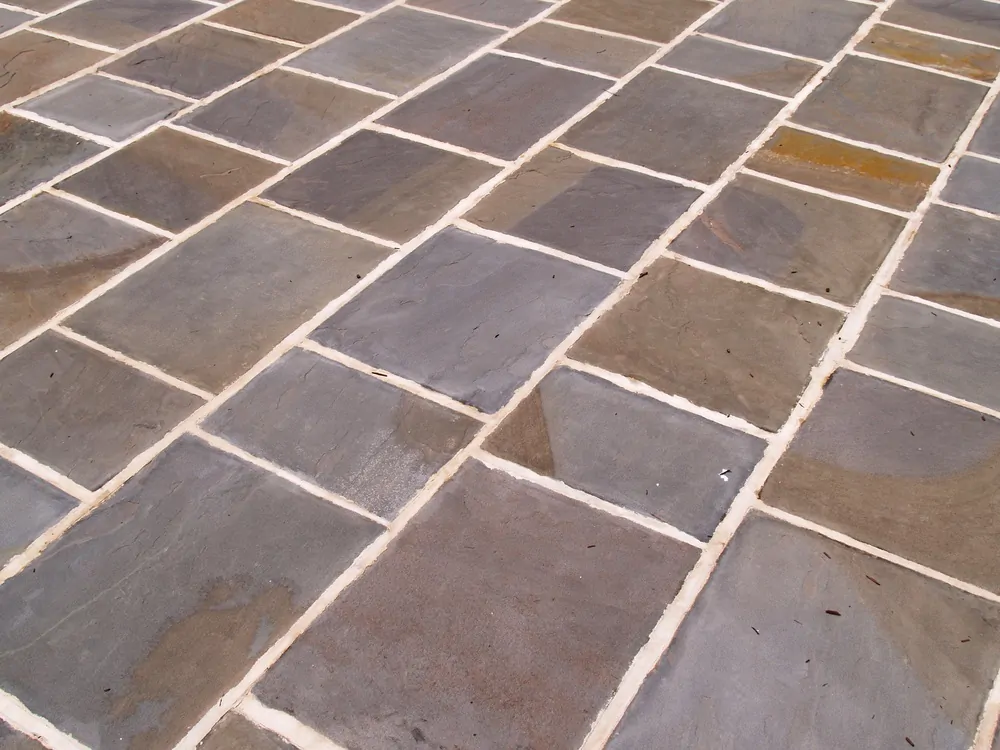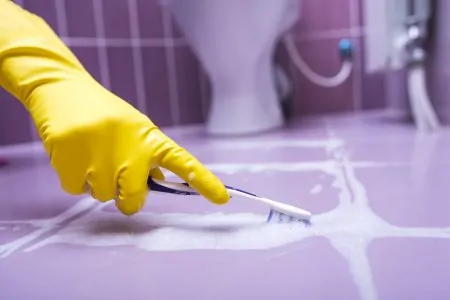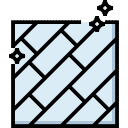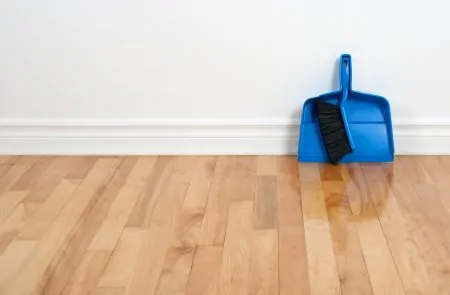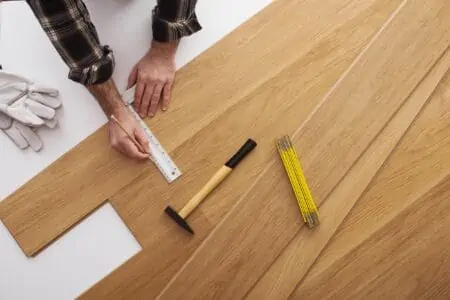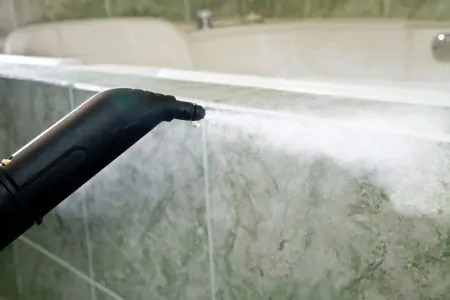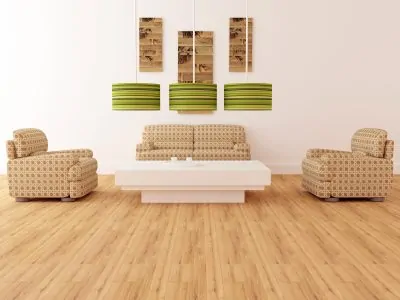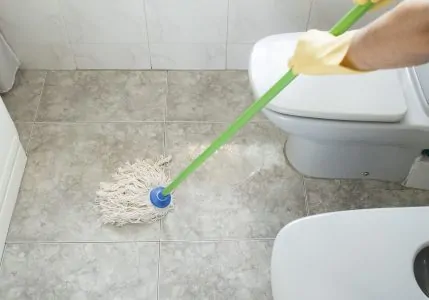Are you worried you might damage your slate floors when cleaning? Your concerns are reasonable. Although slate is a solid stone, it’s also porous and sensitive to certain cleaning products.
These types of floors can bring an earthy feel to any home. But, it’s important to know how to clean slate floors properly. This ensures that you avoid damage and preserve the beautiful surface.
We’ve put together everything you need to know for cleaning slate floors. Now you can get them sparkling clean without causing damage.
Key Takeaways
- Avoid acidic, abrasive, and oil-based cleaners when cleaning slate floors.
- Sweep or vacuum with a soft attachment, then use a damp mop with mild detergent or slate cleaner.
- Remove stains using methods like mild detergent, baking soda and peroxide, or rubbing alcohol.
- Seal slate floors annually to protect the surface and prevent water damage.
What Is Slate Flooring?
Slate flooring is one of the most popular types of natural stone. It’s durable and, with the correct maintenance, long-lasting. Slate is often used in high-traffic areas of a household, such as a busy kitchen.
Homeowners love it because it requires less maintenance and cleaning. Hardwood, tiles, and laminate floors require more frequent cleaning due to dust and dirt.
Fine slate stone is found and mined underground. A cheaper slate can be found closer to or on the ground’s surface. However, just because it’s cheaper doesn’t mean it’s no good. It’s simply not as expensive to extract.
A high-quality slate flooring is stain- and slip-resistant. It’s also non-porous for its lifespan.
Ground slate is known to have a more weathered look due to being exposed to the elements. Although many homeowners prefer this look, it’s porous and should be handled with care (1).
Buying and installing slate floors in your home can take a considerable chunk out of your bank account. It is, therefore, essential that you care for it the right way.
How to Clean Slate Floors
Slate floors don’t require as much attention as other types of flooring. However, when you do clean, you must do it correctly.
- Time: 1 hour
- Difficulty: Easy
There are a few things you should avoid when cleaning this natural stone:
- Acidic cleaners: Acid can cause a chemical reaction when exposed to slate stone. This will cause the floor to etch and become damaged. So avoid acidic cleaners, even natural ones such as vinegar or lemon (2).
- Abrasive cleaners: Strong chemicals can remove the sealer on the floor and grout. This will expose the porous surface to liquids and stains.
- Oil-based cleaners: These will make the floors slippery and can clog up the textured surface.
What You’ll Need
- Broom or vacuum (with a soft attachment and hard floor setting)
- Dust mop with microfiber pad (optional)
- Slate cleaner, mild laundry detergent, or dish soap
- Warm water
- Bucket
- Mop
- Steam mop (optional)
- Teak oil or slate oil
- Soft cloth
1. Sweep or Vacuum
It’s essential to get rid of dust, dirt, and debris before you start mopping. This will make the job easier and enhance the end result. Removing dirt from the floor is also essential to avoid scratches caused by larger soil particles or small rocks.
You can use a soft-bristled broom or vacuum with a soft attachment and hard floor setting. Pay close attention to the crevices between the tiles to get a thorough clean.
Avoid Scratches
You can use a dust mop with a clean microfiber pad if you want a more thorough clean. Glide it over the floor in one direction. This will further help remove dust and debris hiding in the tiny crevices (3).
2. Prepare Your Cleaner
When mopping slate floors, you can use a slate cleaner, mild laundry detergent, or mild dish soap. We suggest you use a commercial product to ensure your floors are protected and for optimal results. You can also use a pH-neutral product.
Use warm water and mix in a quarter cup of detergent or dish soap. If you use a commercial product, follow the instructions on mixing and using it.
3. Use a Damp Mop
Dip the mop in the cleaning solution and wring out the excess. A spin mop is handy for cleaning slate floors because it effortlessly wrings out a significant amount of water.
Do slow and smooth strokes as you clean your way across the floor. Once the mop starts to create streaks of dirt, consider changing the water for a new batch.
You can steam clean your slate floors if you want a deeper clean. Using a steam mop will pick up extra dirt and help to disinfect your floors. Steam mops are a good option for family homes with pets.
4. Wipe the Floor
When you finish mopping, dry the floor thoroughly to avoid standing water from seeping into the pores. Use a soft towel or cloth to wipe the surface.
5. Use Teak Oil
Using teak oil to finish off your floors can enhance the final look after you’ve cleaned. Apply only a small amount using a cloth — don’t soak it or else the pores will absorb the oil. You can use a slate oil, but these tend to be more expensive.
Methods for Removing Stains from Slate Floors
Don’t be disheartened if you’ve issued a general clean but still notice stains. There are a few different methods for removing stains. Here are six to try.
1. Mild Detergent
If you encounter some minor stains or marks while mopping, remove them using the same cleaning solution. Dip a small brush in the solution and gently scrub the stain until it’s gone.
2. Baking Soda and Peroxide
You can make a paste for very stubborn stains using baking soda and peroxide. The combination of these ingredients will effectively lift and dissolve dirt and grease. Therefore, these ingredients are also relatively mild and safe for slate flooring.
Combine equal amounts of peroxide and baking soda and mix until a paste is formed. Wait until the bubbles have stopped, and then apply it to the stain. Allow the paste to sit for a couple of minutes, and then wipe with a cloth (4).
3. Isopropyl Rubbing Alcohol
Ordinary rubbing alcohol is effective at removing stains from slate floors. Combine half a cup of isopropyl rubbing alcohol with four cups of water. Soak a sponge in the solution and wipe the stain. If it doesn’t budge, scrub with slightly more force.
4. Hydrogen Peroxide
Hydrogen peroxide is a mild bleach that works very well at removing stains without causing damage. Combine equal parts of water and hydrogen peroxide in a spray bottle.
Spray the solution onto the stain and allow it to work for 10 minutes. When the time is up, scrub the stain using a brush or sponge. Then rinse thoroughly with clean water.
Take Note
5. Shaving Cream
If you have colored grout, you can use shaving cream to remove stains and blemishes from the floor.
Apply a generous amount of shaving cream directly onto the stain and leave it to sit for 15 minutes. Use warm water and a cloth to wipe it off.
Do A Test
6. Use Absorbent Materials
You might be surprised to see what an absorbent material could do to a new or an old stain. There are several kinds of materials you can try out, such as cat litter, baking soda, and mineral spirits.
Pour the absorbent to cover the stain and give it 10 minutes to absorb a new stain or a few hours if it’s old. Vacuum or sweep the material up once it’s done. If you use cat litter, opt for clay-based as this absorbs faster.
If you’re using baking soda, start by making a paste with water. Cover the stain and allow the paste to dry entirely. Then scrape the dry flakes off and repeat if necessary.
You can also pour mineral spirits onto the stain and leave it for 30 minutes. Scrub with a brush and soak with a newspaper. Finish by washing the area.
Sealing Slate Floors
The best way to protect your slate floors is to seal them. If your floors are unsealed when installed, consider doing it during or right after installation. Or maybe you’ve recently moved to a house with slate floors, and you want to give them an extra coat. But first, determine if it’s necessary.
You might need to use a chemical stripper to remove the old sealant before applying a new one. Some sealers will create a glossy finish, while others are natural-looking. Choose the sealer that works for your type of slate and your style.
Clean and dry the floors thoroughly before applying any sealer. Apply the sealer according to the instructions. Buff the floor using a cotton cloth to remove any excess product once you’re done.
FAQs
Clean Slate
Slate is one of the most desirable natural stone floors — and it’s easy to see why. It has a beautiful weathered, dark look that matches rustic and contemporary homes. Slate is a durable stone, but it can be porous depending on the quality.
You can keep your slate floors looking new by deep cleaning every two or three months. Stay clear of acidic cleaners and consider sealing your floors for extra protection and peace of mind.

